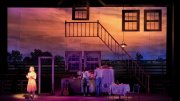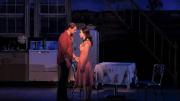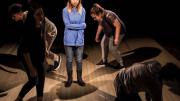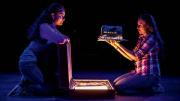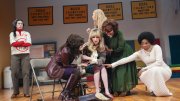Elizabeth Mak ’12, a theater set and lighting designer, doesn’t feel threatened by the era of computer-generated effects and green screens, Avengers and Game of Thrones. In fact, she thinks the rise of television and blockbuster films has been good for artists who work in theater: it challenges them to re-examine what stories they are trying to tell, why and how they are trying to tell them. “Because TV especially has gotten so big in the past 10 years, I think people are starting to think about what separates the two art forms,” she says. “What can theater do that TV and film can’t?”
One thing theater offers, the New York City-based Mak points out, is the creative freedom of conveying precise emotion, rather than the hyperrealism of digital effects. Another is communal experience: “having 500 people in the same room experiencing the same emotion.” Mak’s work often takes this a step further—she frequently collaborates on performances that are immersive, in which performers interact directly with audience members. For her senior thesis, she directed a danced version of The Graveyard Book, Neil Gaiman’s children’s novel about a boy who is raised by ghosts but who grows up to realize that he must eventually enter the human world. Mak used the story to explore what it means to grow up, to preserve childhood memories while also moving on from them. At the end of the performance, the dancers asked each audience member to waltz with them, and eventually rose petals began to sprinkle down on the crowd: they became a part of the set. “And it ends,” Mak says, “with the audience being sent out into the world.”
Mak grew up in Singapore, always assuming that the next phase of her life would be the one when she would have to give up art. She was a dancer as a child—mostly modern, with some ballet and tap—but her middle school fed into Singapore’s top high school, which didn’t offer dance. Her middle-school choreographer, however, happened to teach at a high school that was starting a theater program. “I thought, okay, maybe I’ll transfer and we’ll see what comes of this,” Mak says. She did, and continued to dance throughout high school.
When she arrived at Harvard, she braced herself again to part ways with dance. “Where I come from, people don’t really have careers in the arts. I had never met an artist growing up,” she explains. She thought she would concentrate in English or philosophy, then return to Singapore to be a teacher. But freshman year she discovered the Harvard-Radcliffe Modern Dance Company, where she both danced and choreographed.
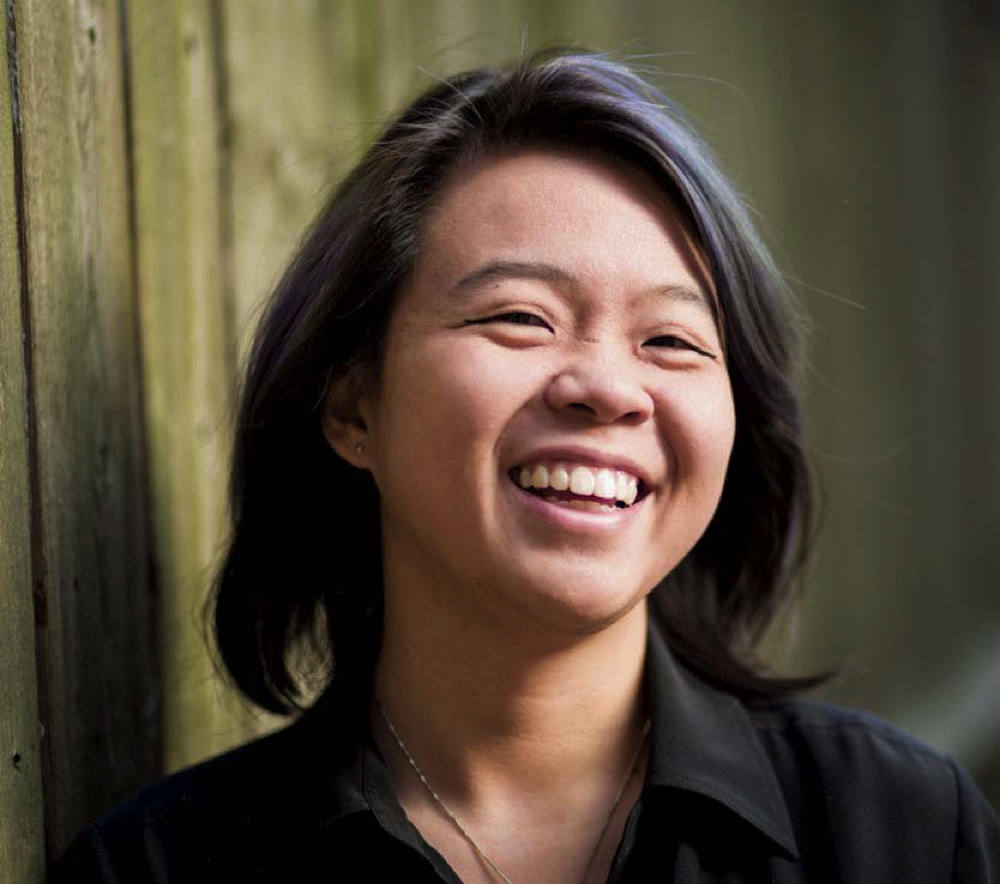
Elizabeth Mak
Photograph courtesy of Elizabeth Mak
She also started volunteering as a stage manager for the Harvard-Radcliffe Dramatic Club. “And somewhere along my freshman year, someone said, ‘We’ve got our spring concert coming up, but there’s no one to do the lighting,’” Mak recalls. “And I said, ‘Well, I don’t really know anything about lighting, but I’ll press some buttons for you.’” The same thing happened when help was needed to build sets. And though her first love was dancing, she had always been introverted, and she discovered that designing the visual elements of a work was a way to communicate stories without the anxiety of performing.
Eventually she found herself working at the American Repertory Theater and doing theater internships. She created a special concentration in performance and theater arts, and went on to an M.F.A. in design at the Yale School of Drama. Now she has the artistic career she once thought impossible, but with it comes a burden she was not expecting. Art, she says, is “something that I do every day now, and it’s something that I 100 percent think has an irreplaceable role in society, but also, with war and poverty and climate change, every day I ask myself: how do we speak to these important issues with art?”
She continues to design more traditional performances, art whose purpose is “entertainment, to make us feel good, to make us laugh”—like a staged version of The Bridges of Madison County, about a mid-twentieth-century Italian war bride who falls in love with a traveling photographer. The play was presented this past February and March by the Philadelphia Theater Company, and Mak was behind the lighting changes crucial to the plot, literally (light dawning over a bridge) and emotionally (the softening of light that evokes falling in love).
Still, she says, “What I’ve been most interested in working on is art that is a call to action.” She collaborates with the Albany Park Theater Project, a company in Chicago that employs local high-schoolers as actors and professional artists like Mak as the surrounding team. Its shows are based on interviews conducted with community members, many of whom are immigrants.
She recently designed lighting and projections for one of these plays, Ofrenda, based on interviews with Albany Park residents about “the meaning of home.” One storyline followed a Syrian refugee who immigrates to Chicago with her family. “It was really important, for design, to think about how to recreate—not recreate—mmm, what’s the word I’m looking for?—for the design to echo the journey that she had been on,” Mak explains.
In the play, the woman is unable to bring photos of her home and family with her when she flees Damascus—but because her father taught her how to draw when she was young, she memorializes Syria through her own art. One of the high-schoolers working for the project created charcoal drawings of Damascus based on the interviewee’s descriptions. To display the woman’s memories of violence, Mak and her colleagues chose to use a 20-minute stop-motion sequence of these drawings, starting with the woman’s school, the tree that grew outside her family’s farm—and ending with the bombings that reduced much of the city to rubble. “We didn’t want to actually recreate realistically what was happening,” Mak says. “It was more important to show the journey that she and her family had been on.”
In 2015, Mak wrote an “artist manifesto” that she keeps posted on her website. “Make art that isn’t afraid to stare down what the rest of the world is afraid to look at,” it reads in part. “Be desperately in love with the world, with everything that is right about it and everything that is wrong about it.” This insistence on loving the world, even while uncovering and displaying its flaws, is unmistakable in the work that Mak brings to life on-stage: horrifying, gritty, hopeful, beautiful.
